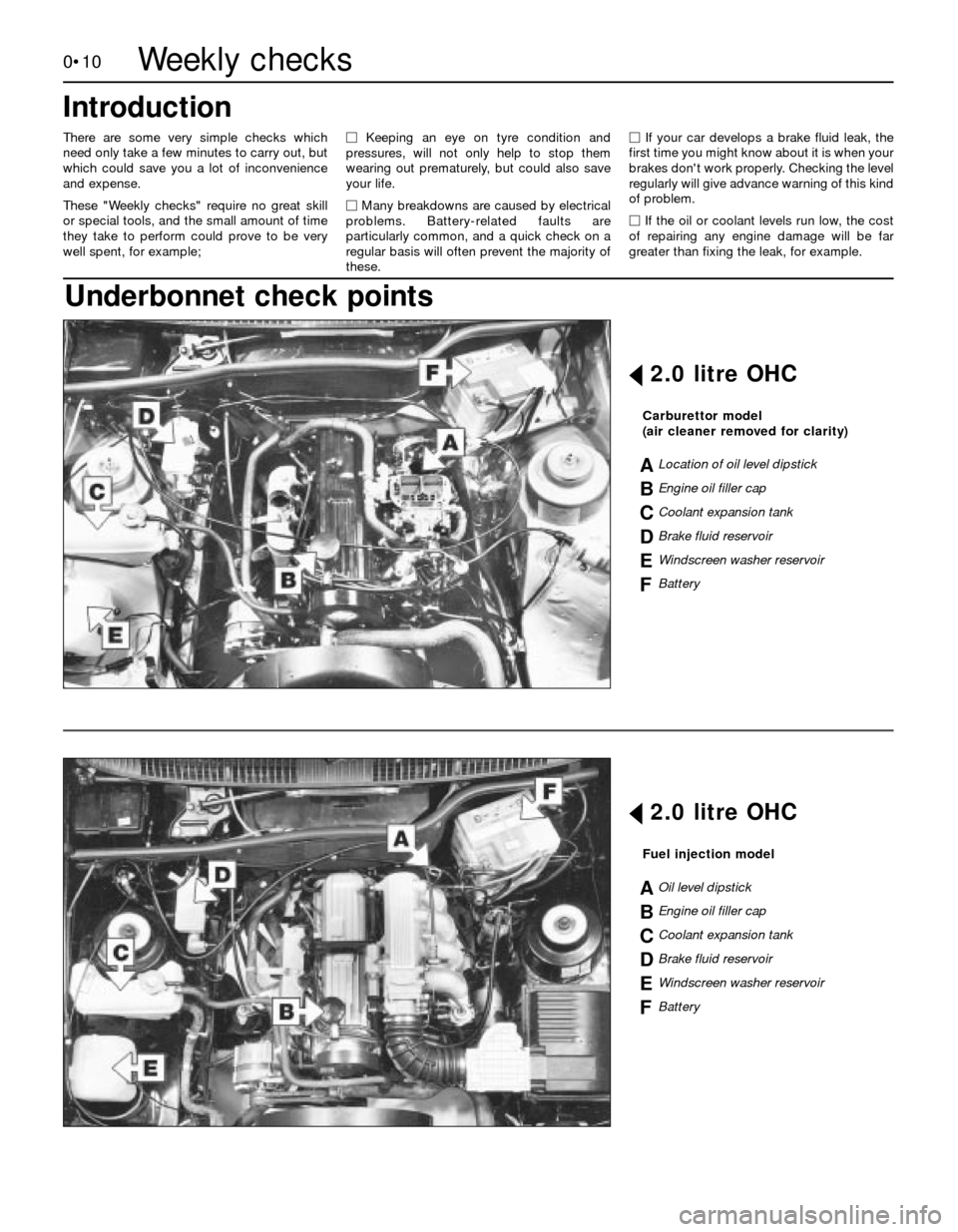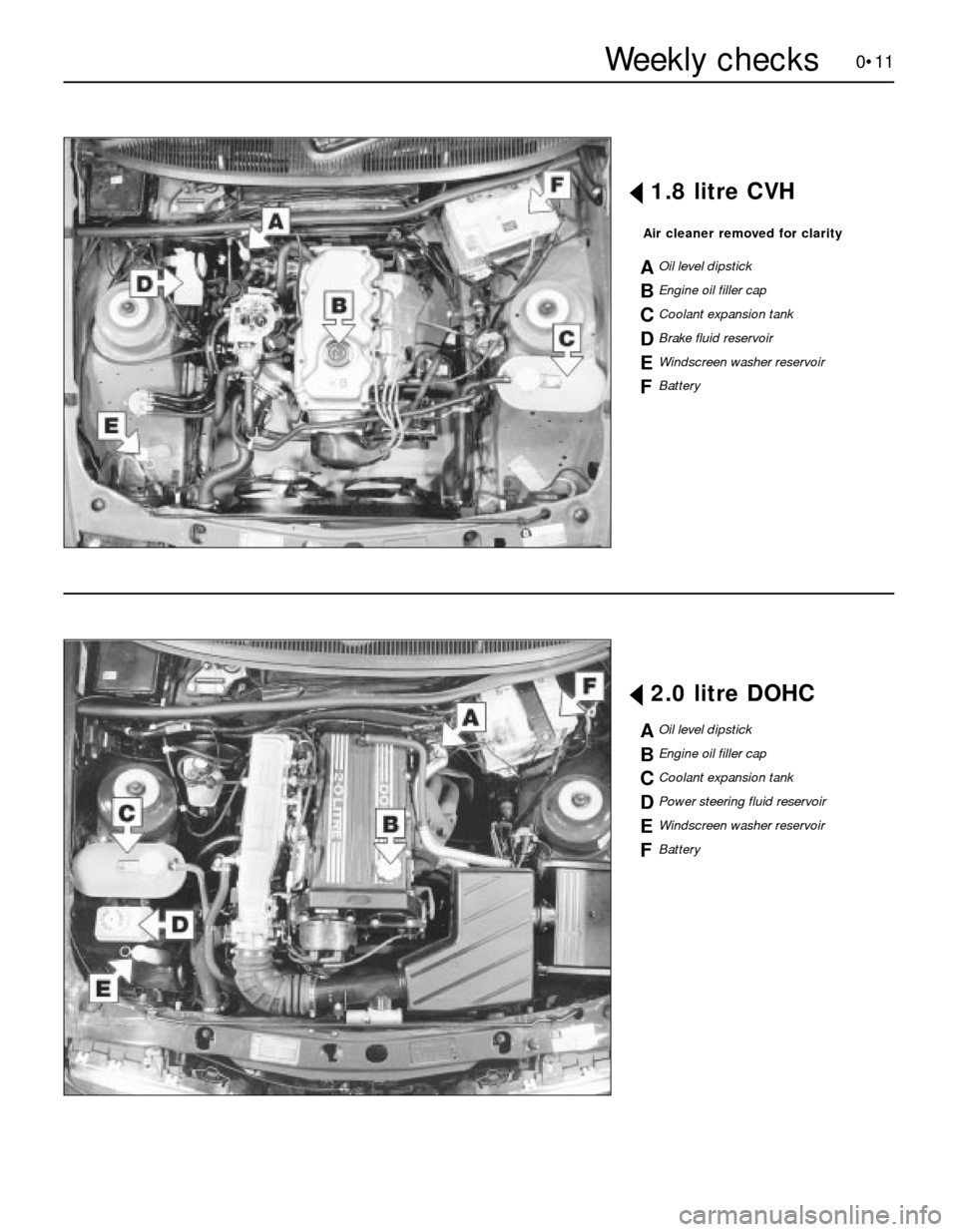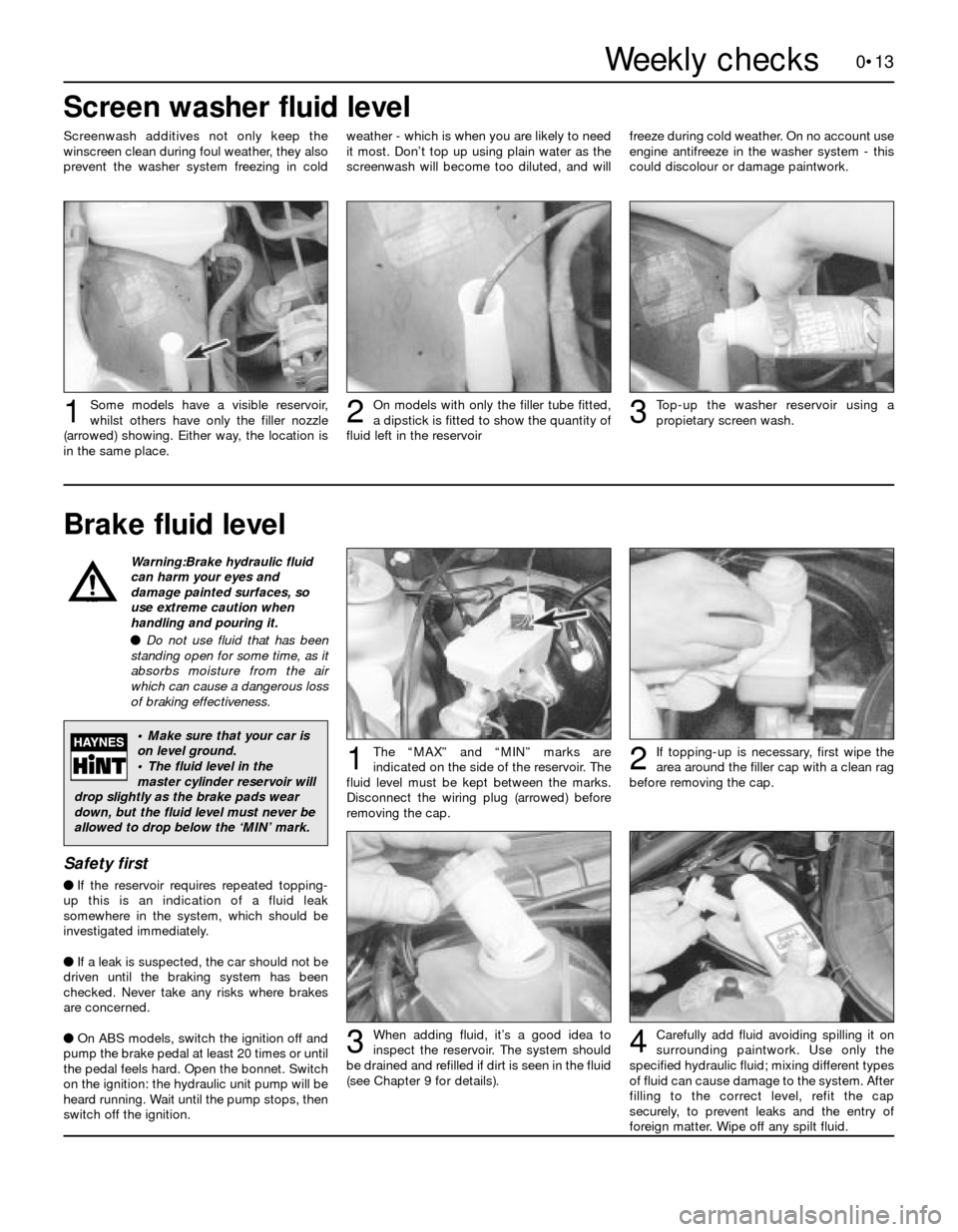washer fluid FORD SIERRA 1989 2.G Introduction Workshop Manual
[x] Cancel search | Manufacturer: FORD, Model Year: 1989, Model line: SIERRA, Model: FORD SIERRA 1989 2.GPages: 18, PDF Size: 0.5 MB
Page 2 of 18

LIVING WITH YOUR FORD SIERRAIntroduction to the Ford SierraPage0•4
AcknowledgementsPage0•4
Safety first!Page0•5
ROADSIDE REPAIRSJacking, vehicle support and wheel changingPage0•6
TowingPage0•7
Identifying leaksPage0•8
Jump startingPage0•9
Weekly Checks
IntroductionPage0•10
Underbonnet check pointsPage0•10
Engine Oil levelPage0•12
Coolant levelPage0•12
Screen washer fluid levelPage0•13
Brake fluid levelPage0•13
Power steering fluid levelPage0•14
Electrical systemsPage0•14
BatteryPage0•15
Wiper bladesPage0•15
Tyre condition and pressurePage0•16
Lubricants and fluidsPage0•17
Tyre pressuresPage0•18
MAINTENANCE
Routine Maintenance and ServicingPage1•1
Maintenance schedulePage1•4
Maintenance proceduresPage1•9
Contents
Page 10 of 18

0•10
There are some very simple checks which
need only take a few minutes to carry out, but
which could save you a lot of inconvenience
and expense.
These "Weekly checks" require no great skill
or special tools, and the small amount of time
they take to perform could prove to be very
well spent, for example;MKeeping an eye on tyre condition and
pressures, will not only help to stop them
wearing out prematurely, but could also save
your life.
MMany breakdowns are caused by electrical
problems. Battery-related faults are
particularly common, and a quick check on a
regular basis will often prevent the majority of
these.MIf your car develops a brake fluid leak, the
first time you might know about it is when your
brakes don't work properly. Checking the level
regularly will give advance warning of this kind
of problem.
MIf the oil or coolant levels run low, the cost
of repairing any engine damage will be far
greater than fixing the leak, for example.
Underbonnet check points
§2.0 litre OHC
Carburettor model
(air cleaner removed for clarity)
ALocation of oil level dipstick
BEngine oil filler cap
CCoolant expansion tank
DBrake fluid reservoir
EWindscreen washer reservoir
FBattery
§2.0 litre OHC
Fuel injection model
AOil level dipstick
BEngine oil filler cap
CCoolant expansion tank
DBrake fluid reservoir
EWindscreen washer reservoir
FBattery
Introduction
Weekly checks
Page 11 of 18

0•11
§1.8 litre CVH
Air cleaner removed for clarity
AOil level dipstick
BEngine oil filler cap
CCoolant expansion tank
DBrake fluid reservoir
EWindscreen washer reservoir
FBattery
§2.0 litre DOHC
AOil level dipstick
BEngine oil filler cap
CCoolant expansion tank
DPower steering fluid reservoir
EWindscreen washer reservoir
FBattery
Weekly checks
Page 13 of 18

Warning:Brake hydraulic fluid
can harm your eyes and
damage painted surfaces, so
use extreme caution when
handling and pouring it.
l Do not use fluid that has been
standing open for some time, as it
absorbs moisture from the air
which can cause a dangerous loss
of braking effectiveness.
Safety first
lIf the reservoir requires repeated topping-
up this is an indication of a fluid leak
somewhere in the system, which should be
investigated immediately.
lIf a leak is suspected, the car should not be
driven until the braking system has been
checked. Never take any risks where brakes
are concerned.
lOn ABS models, switch the ignition off and
pump the brake pedal at least 20 times or until
the pedal feels hard. Open the bonnet. Switch
on the ignition: the hydraulic unit pump will be
heard running. Wait until the pump stops, then
switch off the ignition.
Brake fluid level
0•13
Carefully add fluid avoiding spilling it on
surrounding paintwork. Use only the
specified hydraulic fluid; mixing different types
of fluid can cause damage to the system. After
filling to the correct level, refit the cap
securely, to prevent leaks and the entry of
foreign matter. Wipe off any spilt fluid.When adding fluid, it’s a good idea to
inspect the reservoir. The system should
be drained and refilled if dirt is seen in the fluid
(see Chapter 9 for details).
The “MAX” and “MIN” marks are
indicated on the side of the reservoir. The
fluid level must be kept between the marks.
Disconnect the wiring plug (arrowed) before
removing the cap.1If topping-up is necessary, first wipe the
area around the filler cap with a clean rag
before removing the cap.2
34
Screen washer fluid level
Some models have a visible reservoir,
whilst others have only the filler nozzle
(arrowed) showing. Either way, the location is
in the same place.Top-up the washer reservoir using a
propietary screen wash.On models with only the filler tube fitted,
a dipstick is fitted to show the quantity of
fluid left in the reservoir
Screenwash additives not only keep the
winscreen clean during foul weather, they also
prevent the washer system freezing in coldweather - which is when you are likely to need
it most. Don’t top up using plain water as the
screenwash will become too diluted, and willfreeze during cold weather. On no account use
engine antifreeze in the washer system - this
could discolour or damage paintwork.
123
• Make sure that your car is
on level ground.
• The fluid level in the
master cylinder reservoir will
drop slightly as the brake pads wear
down, but the fluid level must never be
allowed to drop below the ‘MIN’ mark.
Weekly checks